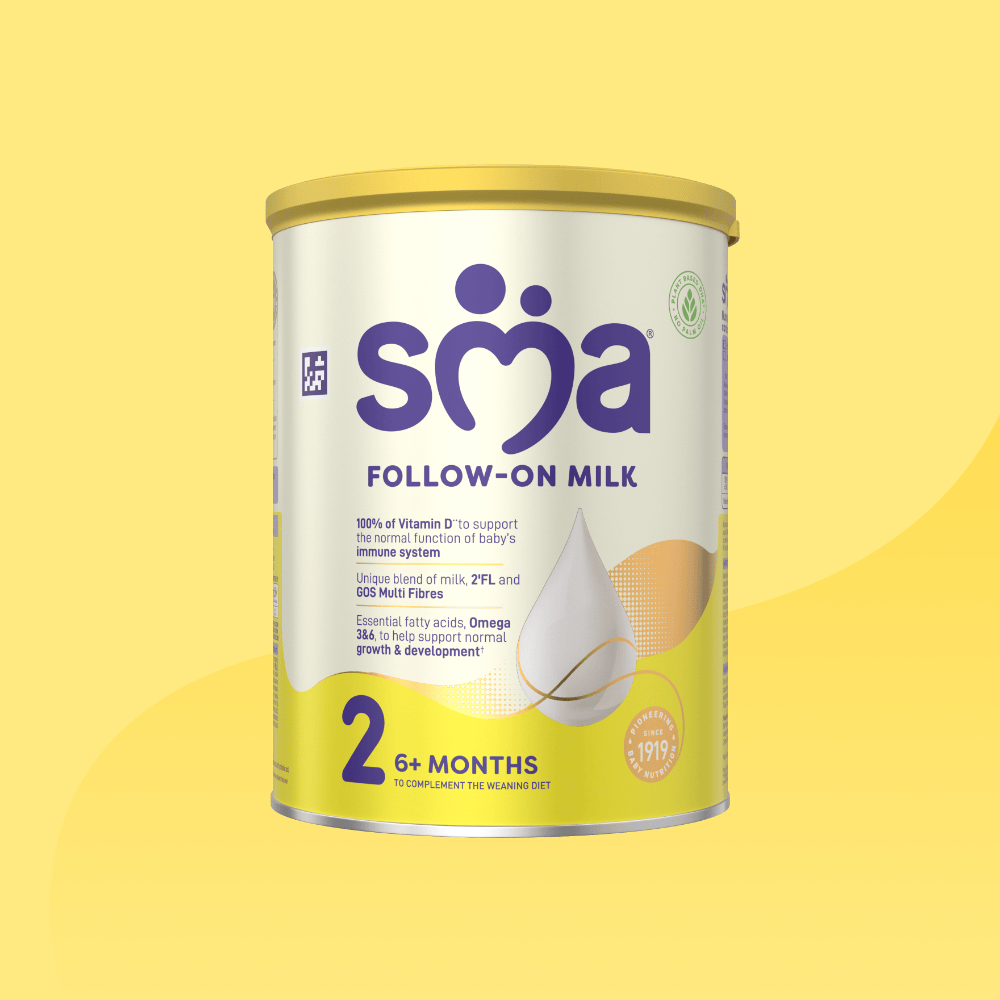SMA® Follow-on Milk
A formula milk containing iron, designed specifically to meet the nutritional needs of babies from 6 months of age as part of a varied weaning diet.
SMA® Follow-on Milk contains 2'FL*
Data cards
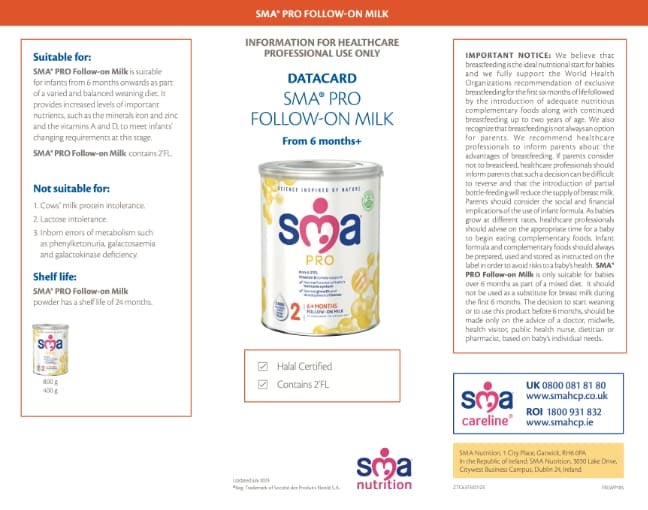
Download the powder format data card
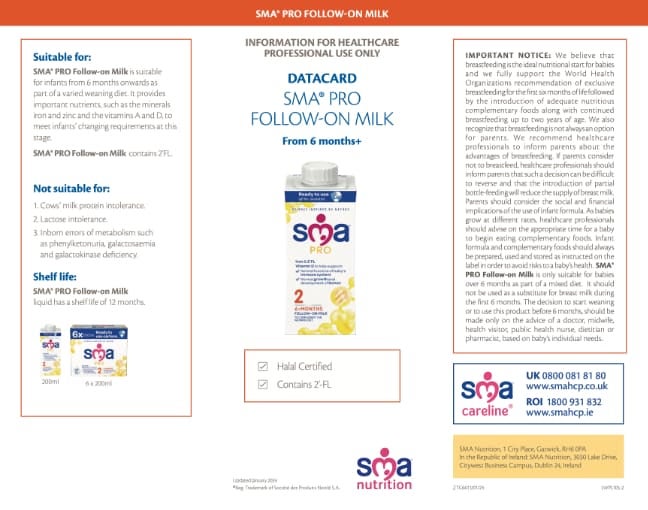
Download the liquid format data card
Product details
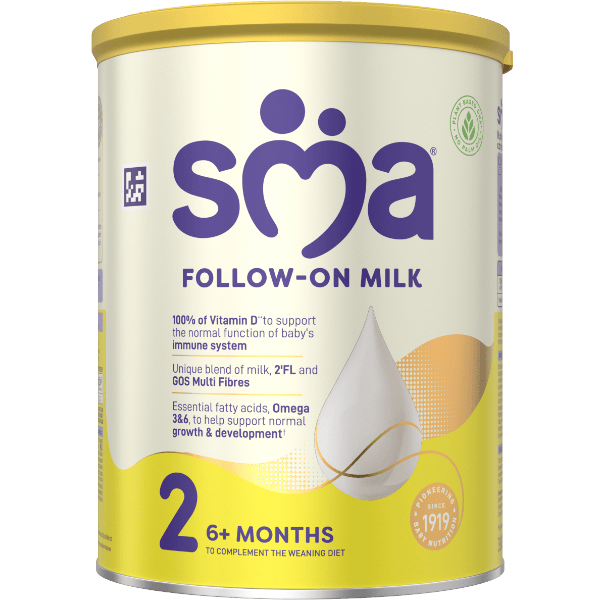
SMA® Follow-on Milk
800 g powder
Easy open lid. Scoop can be stored in suspension inside the can. Use product within 4 weeks of opening. Approximately 177 scoops per can. Approx. 29 x 200 ml servings per can.

SMA® Follow-on Milk
400 g powder
Easy open lid. Use product within 4 weeks of opening. Approximately 88 scoops per can. Approx. 14 x 200 ml servings per can.
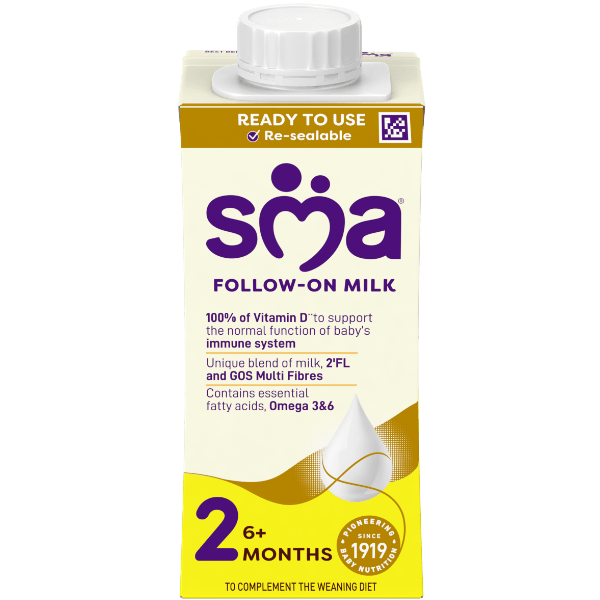
SMA® Follow-on Milk Ready to Drink
200ml Resealable Carton
Ready to use liquids do not require any preparation, just shake and pour into a sterilised beaker/bottle. 200 ml on-the-go resealable cartons are easy to pour and can be kept in the fridge for up to 24 hours after opening.
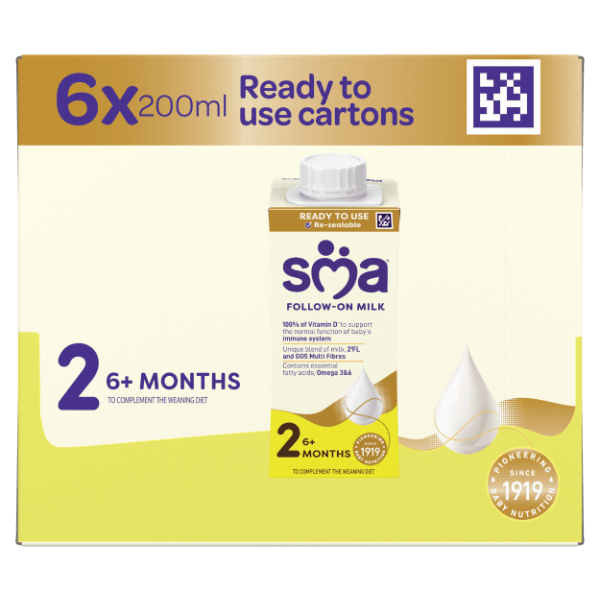
SMA® Follow-on Milk Ready to Drink
6 x 200ml Resealable Carton Multipack
Ready to use liquids do not require any preparation, just shake and pour into a sterilised bottle. Contains 6 x 200 ml on-the-go resealable cartons. Easy to pour and can be kept in the fridge for up to 24 hours after opening.
Feeding guide – powdered milk
| Feeding guide from 6+ months | |||
| 1 serving = 200 ml | Amount of cooled, freshly boiled water | Number of scoops of powder | |
| ml | fl. oz. (approx.) | ||
| 1 beaker/bottle | 180 | 6 | 6 |
This table is a guide only. All babies are different but try to ensure that from 6 months to 1 year a baby has 500 – 600 ml of SMA® Follow-on Milk per day, either as a drink, on cereals or mixed with food. Mix 1 scoop of powder to 30 ml (approx.1fl. oz.) of water. Approx. 177 scoops per can. 1 scoop = 4.5 g. Approx. 29 x 200 ml servings per can (applicable to 800 g can only).
Feeding guide – liquid milk
All babies are different but try to ensure that from 6 months to 1 year a baby has 500 – 600 ml of SMA® Follow-on Milk per day, either as a drink, on cereals or mixed with food.
SMA® Follow-on Milk powder – 800 g and 400 g can
- Do not add extra powder or water to make the feeds stronger or weaker and do not press powder into scoop. Using too much or too little powder can make your baby ill.
- We recommend preparing each feed in individual beakers/bottles when required.
- For hygienic reasons, discard unfinished feed in the beaker/bottle as soon as possible.
- Made-up formulae can be poured over cereals and mixed with food.
- Do not alter or add to formulae unless medically directed.
- Do not warm feeds in a microwave, hot spots may occur and cause scalding.
- Remember, cows' milk should not be used as a drink during the first year.
SMA® Follow-on Milk liquid – 200 ml Tetra-Pak®
- Check best before date.
- Once open, reseal carton and store only in the fridge (5 ºC or below) for up to 24 hours.
- For hygienic reasons, discard unfinished feed in the beaker/bottle as soon as possible, and always within 1 hour.
- For older babies, ready to use formulae can be poured over cereals and mixed with food.
- Do not alter or add to formulae unless medically directed.
- Do not warm feeds in a microwave, hot spots may occur and cause scalding.
- Remember, cows' milk should not be used as a drink during the first year.
- Do not freeze.
Preparation
How to prepare baby's feed – powder (800 g and 400 g)
While this product is made under strict hygienic conditions, it is not sterile. Failure to follow instructions on preparation and storage may make your child ill.
Preparing your baby’s feed – Ready to Use 1 litre and 200 ml tetra pack
Failure to follow instructions on preparation and storage may make your baby ill.
Useful helpsheets for you to share with parents:
English
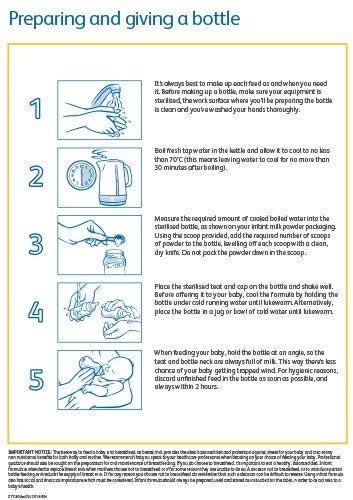
Preparing and giving a bottle
This downloadable helpsheet is available in multiple languages.
English

Steam sterilising
This downloadable helpsheet is available in multiple languages.
- Inostroza J, et al. Low-protein formula slows weight gain in infants of overweight mothers. JPGN 2014; 59: 70-77.
- Ziegler EE, et al. Adequacy of infant formula with protein content of 1.6 g/100 kcal for infants between 3 and 12 months. JPGN 2015; 61: 596-603.
- SMA® PRO Follow-on Milk datacard.
- Aptamil datacard for Follow-on Milk. Available at: https://www.nutricia.co.uk/hcp/products.html (accessed January 2021)
- Cow and Gate datacard for Follow-on Milk. Available at: https://www.nutricia.co.uk/hcp/products.html (accessed January 2021)
- HIPP datacard for Follow-on Milk. Available at: https://hcp.hipp.com/products/hipp-milk-formulae/organic-milk-formula/hipp-2-organic/ …. (accessed January 2021).
- Baird et al., Being big or growing fast: systematic review of size and growth in infancy and later obesity. BMJ, doi:10.1136/bmj.38586.411273.EO after rapid growth.
- Weber et al., Lower protein content in infant formula reduces BMI and obesity risk at school age: follow-up of a randomized trial. Am J Clin Nutr 2014;99:1041–51 for higher risk of obesity
- Scientific Opinion on the substantiation of a health claim related to Vitamin D and contribution to the normal function of the immune system pursuant to Article 14 of Regulation (EC) No. 1924/2006. EFSA Journal 2015; 13(5);4906
- Goehring KC et al. Similar to Those Who Are Breastfed, Infants Fed a Formula Containing 2’- Fucosyllactose Have Lower Inflammatory Cytokines in a Randomized Controlled Trial J Nutr. 2016;146:2559–2566.
- Vandenplas et al., Human Milk Oligosaccharides: 2-Fucosyllactose (2-FL) and Lacto-N-Neotetraose (LNnT) in Infant Formula. Nutrients 2018, 10, 1161;
- Lennox A et al. (2013) Diet and Nutrition Survey of Infants and Young Children. Available at: https://www.gov.uk/government/publications/diet-and-nutrition-survey-of-infants-and-young-children-2011 (accessed February 2020).
- Irish Universities Nutrition Alliance. National Pre-School Nutrition Survey Summary Report on: Food and Nutrient Intakes, Physical Measurements and Barriers to Healthy Eating, June 2012.
- Domellöf M. et al., Iron Requirements in Infancy Ann Nutr Metab 2011;59:59–63
- Department of Health, Dietary Reference Values for Food Energy and Nutrients for the United Kingdom, HMSO, 1991.
- SACN Vitamin D and Health, 2016
- Alexander DD et al. Growth of infants consuming whey-predominant term infant formulas with a protein content of 1.8g/100kcal: a multi-center pooled analysis of individual participant data. Am J Clin Nutr 2016; 104: 1083–1092
- Kramer MS et al Feeding effects on growth during infancy J Pediatr 2004; 145:500–505
- World Health Organization (2013). Long-term effects of breastfeeding: a systematic review on the benefits of breastfeeding on diarrhoea and pneumonia mortality. Available at: https://iris.who.int/server/api/core/bitstreams/b7fdc85b-8623-495b-978f-01079bdef07b/content (Accessed July 2020)
- Bode L. Human milk oligosaccharides: every baby needs a sugar mama. Glycobiology 2012; 22(9): 1147–62.
- Jantscher-Krenn E, Bode L. Human milk oligosaccharides and their potential bene ts for the breast-fed neonate. Minerva Pediatr 2012; 64(1): 83–99.
*2'FL: structurally identical human milk oligosaccharides, not sourced from breast milk
LRNI - Lower Reference Nutrient Intakes
IMPORTANT NOTICE:
The World Health Organisation (WHO) recommends exclusive breastfeeding during the first 6 months of life and continued breastfeeding for as long as possible. SMA® PRO Follow-on Milk is only suitable for babies over 6 months as part of a mixed diet. It should not be used as a substitute for breast milk during the first 6 months. The decision to start weaning or to use this product before 6 months, should be made only on the advice of a doctor, midwife, health visitor, public health nurse, dietitian or pharmacist, based on baby’s individual needs.

